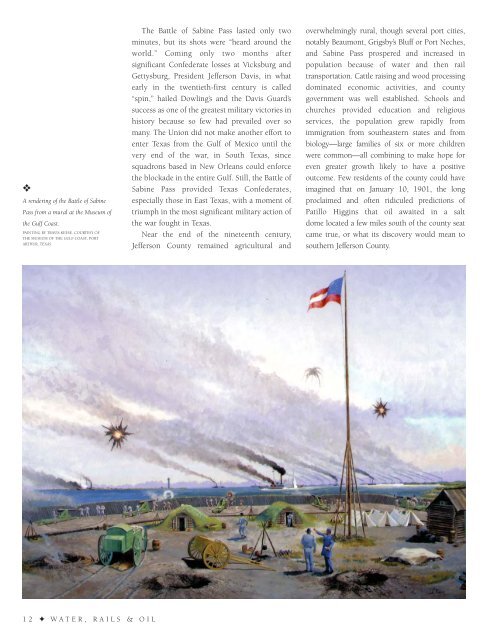Water Rails & Oil - Historic Mid & South Jefferson County
An illustrated history of the Mid and South Jefferson County area, paired with the histories of companies, families and organizations that make the region great.
An illustrated history of the Mid and South Jefferson County area, paired with the histories of companies, families and organizations that make the region great.
Create successful ePaper yourself
Turn your PDF publications into a flip-book with our unique Google optimized e-Paper software.
❖<br />
A rendering of the Battle of Sabine<br />
Pass from a mural at the Museum of<br />
the Gulf Coast.<br />
PAINTING BY TRAVIS KEESE. COURTESY OF<br />
THE MUSEUM OF THE GULF COAST, PORT<br />
ARTHUR, TEXAS.<br />
The Battle of Sabine Pass lasted only two<br />
minutes, but its shots were “heard around the<br />
world.” Coming only two months after<br />
significant Confederate losses at Vicksburg and<br />
Gettysburg, President <strong>Jefferson</strong> Davis, in what<br />
early in the twentieth-first century is called<br />
“spin,” hailed Dowling’s and the Davis Guard’s<br />
success as one of the greatest military victories in<br />
history because so few had prevailed over so<br />
many. The Union did not make another effort to<br />
enter Texas from the Gulf of Mexico until the<br />
very end of the war, in <strong>South</strong> Texas, since<br />
squadrons based in New Orleans could enforce<br />
the blockade in the entire Gulf. Still, the Battle of<br />
Sabine Pass provided Texas Confederates,<br />
especially those in East Texas, with a moment of<br />
triumph in the most significant military action of<br />
the war fought in Texas.<br />
Near the end of the nineteenth century,<br />
<strong>Jefferson</strong> <strong>County</strong> remained agricultural and<br />
overwhelmingly rural, though several port cities,<br />
notably Beaumont, Grigsby’s Bluff or Port Neches,<br />
and Sabine Pass prospered and increased in<br />
population because of water and then rail<br />
transportation. Cattle raising and wood processing<br />
dominated economic activities, and county<br />
government was well established. Schools and<br />
churches provided education and religious<br />
services, the population grew rapidly from<br />
immigration from southeastern states and from<br />
biology—large families of six or more children<br />
were common—all combining to make hope for<br />
even greater growth likely to have a positive<br />
outcome. Few residents of the county could have<br />
imagined that on January 10, 1901, the long<br />
proclaimed and often ridiculed predictions of<br />
Patillo Higgins that oil awaited in a salt<br />
dome located a few miles south of the county seat<br />
came true, or what its discovery would mean to<br />
southern <strong>Jefferson</strong> <strong>County</strong>.<br />
12 ✦ WATER, RAILS & OIL
















